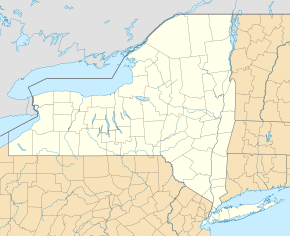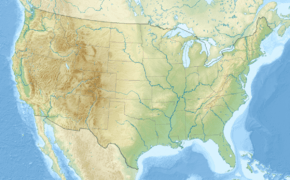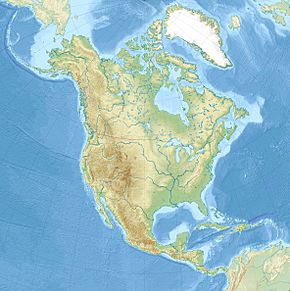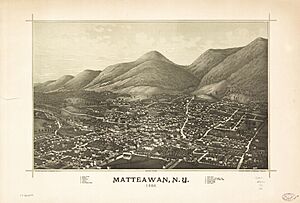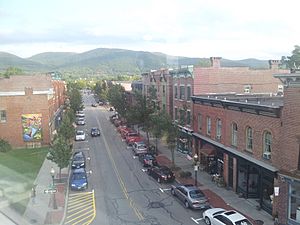Beacon, New York facts for kids
Quick facts for kids
Beacon, New York
|
|||
|---|---|---|---|
Skyline of Beacon (2007)
|
|||
|
|||
| Nickname(s):
Tree City
|
|||
Location of Beacon, New York
|
|||
| Country | United States | ||
| State | New York | ||
| County | Dutchess | ||
| Government | |||
| • Type | Mayor-Council | ||
| Area | |||
| • Total | 4.88 sq mi (12.63 km2) | ||
| • Land | 4.74 sq mi (12.27 km2) | ||
| • Water | 0.14 sq mi (0.35 km2) | ||
| Elevation | 138 ft (42 m) | ||
| Population
(2020)
|
|||
| • Total | 13,769 | ||
| • Density | 2,905.47/sq mi (1,121.81/km2) | ||
| Time zone | UTC-5 (EST) | ||
| • Summer (DST) | UTC-4 (EDT) | ||
| ZIP code |
12508
|
||
| Area code(s) | 845 | ||
| FIPS code | 36-05100 | ||
| GNIS feature ID | 0977521 | ||
Beacon is a city in New York, located right on the Hudson River in Dutchess County. In 2020, about 13,769 people lived there. Beacon is part of a larger metropolitan area that includes New York City.
The city got its name from special fires, called "beacon fires." These fires were lit on top of the Fishkill Mountains during the American Revolutionary War. They warned the Continental Army about British troop movements. Beacon used to be a city known for its factories. But since 2003, it has become famous for Dia Beacon, a huge modern art museum. This has helped the city grow and change a lot.
The area that is now Beacon was first settled by Europeans in 1709. It started as two villages: Matteawan and Fishkill Landing. These were some of the first communities in Dutchess County. Beacon is in the southwestern part of Dutchess County. It's about 90 miles (145 km) south of Albany and 60 miles (97 km) north of New York City.
Contents
History of Beacon
In 1683, two fur traders from New York City, Francis Rombout and Gulian Verplanck, bought land from the Wappinger tribe. This land later became the City of Beacon. The King of England, James II, approved this sale in 1685. When Rombout died, his share of the land went to his daughter, Catheryna Brett. In 1706, the land was divided, and Catheryna received about 28,000 acres (113 km2) along the Vis Kill.
Catheryna Brett sold some of her land to other settlers. She often kept the right to build flour mills on the property. In the early 1800s, Dutchess County was a top producer of wheat in New York. Mills on Brett's land attracted farmers from all over. In 1748, Brett and other settlers built the Frankfort Store House near the water. This started river shipping in the area, and Fishkill Landing grew into a busy port. By 1780, about two dozen ships operated from Fishkill Landing. The village of Fishkill Landing officially became a town in 1864.
Matteawan was located on the Fishkill Creek, about a mile and a half east of Fishkill Landing. The creek's water power helped Matteawan become a center for manufacturing. It was also a stop for several railroads.
Beacon's Role in War and Industry
During the American Revolutionary War, Beacon played an important role. It produced war supplies and served as a fort and signaling point. The city's name comes from the signal fires lit on top of nearby Mount Beacon.
In the 1800s, Beacon became a factory town. It was known as "The Hat Making Capital of the US." At one point, nearly 50 hat factories were operating there. The Matteawan Manufacturing Company was the first hat factory, employing 500 workers. Other factories, like Dutchess Hat Works, made huge numbers of hats every day.
Beacon officially became a city in 1913. It combined the villages of Fishkill Landing and Matteawan. It also included a small part of the hamlet of Glenham.
In the 1960s, some important historic buildings were torn down to make way for new developments. In the 1970s, many of Beacon's factories closed due to a decline in the economy. This led to a difficult time for the city, with many empty businesses and factories. However, things started to change in the late 1990s. The opening of Dia Beacon in 2003, one of the world's largest contemporary art museums, brought new life to the city. Beacon began an artistic and business rebirth, and new development continues today.
Geography and Location
Beacon covers about 4.9 square miles (12.6 km2). Most of this is land, with a small amount of water, including the Beacon Reservoir.
Beacon is on the eastern side of the Hudson River. It's close to many historic places and big cities. For example, it's just minutes away from Bannerman's Castle and West Point. Beacon also has the famous Mount Beacon behind it and the Hudson River in front. The city is across the river from Newburgh. It's also only 20 minutes south of Poughkeepsie, the capital city of the Hudson Valley Region. Danbury, Connecticut, is about 30 miles (48 km) to the east, and New York City is 55 miles (89 km) to the south.
Beacon's Neighborhoods
Beacon has several neighborhoods:
- Main neighborhoods
- Riverside section
- Mountainside section
- Secondary neighborhoods
- North tree streets
- South tree streets
- Business district (Main Street area)—This area has been updated over the last ten years. It now has many artists' studios, shops, and restaurants.
- "Davies" or "the apartments" (This part of the city has a lot of public housing on South Avenue.)
- "Forrestal Heights"—This area also has housing for elderly people and other residents.
- "The Derk" (This neighborhood is east of Fishkill Creek, near Beacon Fire Station 1.)
Historic Neighborhoods and Places
The first few blocks of Main Street, east of South Avenue, form the Lower Main Street Historic District. This area has many small businesses in old buildings with an Italianate style.
Here are some important historic places in Beacon:
- Bogardus-DeWindt House is an old house built between 1750 and 1830. It's on the National Register of Historic Places.
- Madam Brett Homestead, at 50 Van Nydeck Avenue, is the oldest building in Dutchess County. It is also on the National Register of Historic Places.
- Denning's Point is a piece of land that goes into the Hudson River. It used to be a brickyard and other industries. Now, it's home to The Beacon Institute for Rivers and Estuaries. Some believe Alexander Hamilton lived here during the Revolutionary War.
- Eustatia is a brick house built in 1867. It overlooks the Hudson River and is known for its High Victorian Gothic style. It was added to the National Register of Historic Places in 1979.
- The Howland Cultural Center on Main Street used to be the Howland Circulating Library. It was designed in 1872 by Richard Morris Hunt. Today, it's a non-profit organization that hosts art shows and other cultural events. It was added to the National Register of Historic Places in 1973.
- Lewis Tompkins Hose Company No. 1 Firehouse
- Madam Brett Homestead
- Mount Gulian
- Dia Beacon, this museum has a collection of modern art from the 1960s to today. It is located in a former Nabisco box-printing factory.
- Peter C. DuBois House
- Reformed Church of Beacon is the oldest church in Beacon, established in 1813. It overlooks the Hudson River and was added to the National Register of Historic Places in 1988.
- St. Joachim and St. John the Evangelist's Church (Beacon, New York)
- St. Luke's Episcopal Church (Beacon, New York)
- Tioronda Bridge
- Trinity Methodist Church (Beacon, New York)
- United States Post Office is on Main Street. It's a stone building built in the 1930s. It has a mural inside by Charles Rosen. It was listed on the National Register of Historic Places in 1988.
- Beacon is home to one of the few "dummy lights" in the United States. The Beacon Dummy Light is a traffic signal on a pedestal in the middle of an intersection. It was first installed in 1926 and was restored in 2022.
People and Population
| Historical population | |||
|---|---|---|---|
| Census | Pop. | %± | |
| 1920 | 10,996 | — | |
| 1930 | 11,933 | 8.5% | |
| 1940 | 12,572 | 5.4% | |
| 1950 | 14,012 | 11.5% | |
| 1960 | 13,922 | −0.6% | |
| 1970 | 13,255 | −4.8% | |
| 1980 | 12,937 | −2.4% | |
| 1990 | 13,243 | 2.4% | |
| 2000 | 13,808 | 4.3% | |
| 2010 | 15,541 | 12.6% | |
| 2020 | 13,769 | −11.4% | |
| U.S. Decennial Census | |||
The 2010 United States census showed Beacon's population was 15,541. By the 2020 census, the population was 13,769.
In 2000, there were 13,808 people living in Beacon. About 68% of the population was White, and about 31% were from minority groups. The largest minority group was African Americans, making up about 19% of residents. Hispanic or Latino people made up about 16% of the city.
About 34% of households had children under 18 living with them. The average household had 2.61 people. The median age in the city was 36 years old.
Getting Around Beacon
Public Transportation
Train Service
Metro-North
You can take a train to New York City from the Beacon Train Station. This station is on the Hudson Line, served by Metro-North Railroad.
Beacon Incline Railway
From 1902 to 1978, the Mount Beacon Incline Railway was one of the steepest railways of its kind. It took millions of people up to the 1,540-foot (469 m) summit of Mount Beacon. Sadly, fire and vandalism destroyed it. Efforts to reopen it ended in 2022 because enough money couldn't be raised.
Newburgh-Beacon Ferry
The Newburgh–Beacon Ferry crosses the Hudson River. It connects Newburgh with Beacon. It mostly carries people who are commuting to work during busy hours.
Buses
Dutchess County Public Transit runs public bus service in and around Beacon. Buses run on weekdays and Saturdays, with limited service on Sundays.
- Route A goes from downtown Beacon to Fishkill and then north to Poughkeepsie.
- Route B travels from Beacon north to Poughkeepsie along NY 9D and US 9.
- Route F goes northeast from Beacon through Fishkill to Hopewell Junction.
Beacon Free Loop
Beacon also has the Beacon FREE Loop. This is a free bus service that runs Monday to Saturday. It stops at the Beacon Metro-North Station, Dia:Beacon, Main Street, and the Mount Beacon parking lot.
Roads and Highways
Beacon's main highway is Interstate 84 (I-84). It passes through the north side of the city. This highway connects to the Taconic State Parkway and the New York State Thruway. The city also has the Newburgh-Beacon Bridge, which carries I-84 over the Hudson River.
New York State Route 9D (NY 9D) is a major north-south road in the city. New York State Route 52 Business (NY 52 Business) runs across the middle of the city.
Airports Near Beacon
The Dutchess County Airport is nearby in the Town of Wappinger. It handles local flights. The closest major airport is Stewart International Airport, about 20 minutes away in Newburgh.
Community Groups and Media
Beacon Sloop Club
The Beacon Sloop Club started in 1978. It was founded with the help of famous folk singer Pete Seeger and his wife Toshi Seeger. The club's goal is to protect the Hudson River and its environment. They also organize fun activities like picnics and festivals on the waterfront. They teach people about sailing and boating safety. Each year, the club hosts the Strawberry Festival, Corn Festival, and Pumpkin Festival. These events raise money for community activities and spread awareness about environmental issues.
Beacon Climate Action Now (BCAN)
Beacon Climate Action Now (BCAN) is a group that works for climate justice. They are active in Beacon and the surrounding Hudson Valley.
Campaigns
BCAN's first big project was to ban natural gas in new buildings in Beacon. They worked hard through public events and partnerships with other groups. On March 20, 2023, the Beacon City Council voted to pass a law requiring new buildings to use electricity instead of fossil fuels. Beacon became the third city in New York State to do this.
Local Media
Beacon has two weekly newspapers: The Highlands Current (published Fridays) and the Beacon Free Press (published Wednesdays). The AM radio station WBNR is also based in Beacon.
Fun Things to Do in Beacon
Museums and Institutes
- Dia Beacon: A museum with a large collection of modern art.
- The Beacon Institute of Rivers and Estuaries: A research center focused on rivers and estuaries.
Parks and Recreation
- Bannerman Castle Trust: Works with the Beacon Historical Society.
- Forrestal Park: A large playground with a basketball court, popular with local kids.
- Green Street Park: A neighborhood park in the Mountainside section.
- Hammond Field: A park mainly used for school sports, home to the "Beacon Bulldogs" track and football teams.
- Greenway Trail: A public trail along Fishkill Creek.
- Hudson Highlands State Park: A large state park behind and south of the city, covering Mount Beacon.
- Memorial Park: The city's main park, located in the center. Many community events are held here.
- Mt. Beacon Park: Has hiking trails and access to the Mt. Beacon Fire Observation Tower.
- Hudson Highlands Fjord Trail: A planned path for walking and biking that will connect downtown Beacon and Cold Spring. It will help hikers reach trails in Hudson Highlands State Park.
- The Pete and Toshi Seeger Riverfront Park: The city's park along the Hudson River. It hosts many events and was renamed in 2014.
- River Pool at Beacon: A project to clean up the Hudson River and create a safe swimming spot.
- University Settlement Park: This park has a theater space and is home to the Beacon Glades Disc Golf Course. It also has The Beacon Pool, an outdoor pool open to the community in the summer.
Commercial Spaces
- Beacon Theatre (Beacon, New York)
- Towne Crier Cafe
Sports in Beacon
Professional Sports Teams Nearby
- Hudson Valley Renegades: A minor league baseball team for the New York Yankees. They play their home games in Dutchess Stadium in nearby Fishkill.
- Hudson Valley Hawks: A semi-professional basketball team that played games at Beacon High School.
- The Hudson Valley Bears: An ice hockey team that played games in nearby Poughkeepsie.
Amateur Sports
- The Hudson Valley Rebels: An amateur rugby club with both women's and men's teams.
- Beacon Glades: An 18-hole disc golf course at the University Settlement camp. It's free and open to the public.
- Beacon High School has a Fitness Center and a 25-yard swimming pool. These are open to the public for membership.
Famous People from Beacon
Born in Beacon
- Nick Acquaviva: A composer, pianist, and band leader.
- Tony Acquaviva: A composer and conductor who founded the New York Pops Symphony Orchestra.
- Melio Bettina: A boxer who was the World Light Heavyweight Champion in 1939.
- Wallace E. Conkling: The seventh bishop of the Episcopal Diocese of Chicago.
- James Forrestal: Served as Secretary of the Navy and the first Secretary of Defense for the United States.
- Elijah Hughes: A professional basketball player.
- Paul Lavalle: A conductor and composer known for his work in radio and for forming the McDonald's All-American High School Band.
- Robert Montgomery: An actor and director, and father of actress Elizabeth Montgomery.
- Digger Phelps: A famous college basketball coach for Notre Dame.
- Ann E. Rondeau: A retired US Navy Vice Admiral.
- Louis W. Stotesbury: A US Army brigadier general.
- Lenny Torres: A baseball player.
People Who Lived in Beacon
- Joseph Bertolozzi: A composer and musician.
- Mel Birnkrant: A toy designer and collector.
- Frances Hodgson Burnett: An English author.
- Ron English: An American contemporary artist.
- William Few: One of the Founding Fathers of the United States.
- Eliza Howland: An American author.
- Joseph Howland: A Civil War general and generous helper of the community.
- Bruce Molsky: A musician who plays old-time fiddle, guitar, and sings.
- David Rees: A cartoonist and humorist.
- Henry Winthrop Sargent: A horticulturist and landscape gardener.
- Pete Seeger: A famous folk singer and activist.
- Toshi Seeger: An environmental activist and filmmaker.
- Clifford Shull: A Nobel Prize-winning physicist.
- Doug and Mike Starn: American artists.
- Elmer Steele: A Major League Baseball pitcher.
See also
 In Spanish: Beacon (Nueva York) para niños
In Spanish: Beacon (Nueva York) para niños


